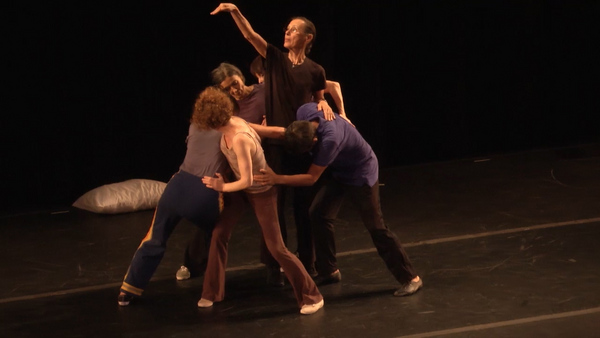Martin Hargreaves
dal 13/7/2015 al 13/7/2015
Segnalato da
Ufficio Stampa Fondazione Ratti
13/7/2015
Martin Hargreaves
Fondazione Antonio Ratti - Villa Sucota, Como
Lecture - Shaking the Dust: Performance as material as performance. La conferenza parte da due proposte; in primis l'idea del corpo come archivio e secondariamente come sia possibile creare lavori performativi da altre performance.

----- english below
La conferenza partirà da due proposte; in primis l'idea del corpo come archivio e secondariamente come sia possibile creare lavori performativi da altre performance. I temi della conferenza si ricollegano alla definizione di "coreografia indessicale" di Yvonne Rainer: "avere una conversazione in pubblico con ciò o chi ci ha preceduto". Ci si interrogherà quindi se il turbinio di fantasmi smossi da un passo di danza possa diventare una tempesta di polvere che, paradossalmente, ci aiuta a vedere in modo differente.
Andre Lepecki, nel 2010, ha definito una caratteristica della danza contemporanea come "attivazione coreografica del corpo del danzatore come un archivio eternamente creativo e in continua trasformazione.". Nella conferenza Martin Hargreaves esporrà i possibili risultati dell'analisi del corporeo come archivio. Considerando l'insistente interesse al soggetto dell'archivio nato dopo la pubblicazione del libro "Mal d'archivio" di Jacques Derrida, Carolyn Steedman afferma che questa ossessione è in parte dovuta alla natura materiale degli archivi: la polvere. La polvere porta con sé il lavoro impiegato per la produzione di un testo e anche ciò che ne rimane, e può essere accidentalmente inalata o digerita e quindi incorporata da chiunque tenti di comprenderne la storia. Questa polvere potrebbe essere quel sedimento di cui scrive Judith Butler quando descrive come i gesti performativi riescano a svelare la comparsa della soggettività; "una sedimentazione, una ripetizione che si solidifica"? Il corpo, per Butler, è in parte l'archivio materiale e misterioso dell'abitudine comportamentale, quell'abitudine normata alla disciplina, al parlare e al toccarsi, ma è anche, in modo altrettanto importante, la materializzazione di un potenziale che rivela la costituzione del corpo stesso. Quando siamo invitati a leggere la storia di una performance ci è anche data la possibilità di intavolare una conversazione su come il corpo metta in scena la sua stessa materialità?
Martin Hargreaves è scrittore, drammaturgo e performer. Dal 2003 al 2013 è stato editor del Dance Theatre Journal e ha scritto su una varietà di temi, tra i quali le origini omosessuali del Butoh, l'etica e la politica del lavoro di Raimund Hoghe e gli scambi tra visual arts e danza dagli anni '60. L'interesse principale della sua ricerca nella prima coreografia postmoderna e nella performance art ha portato alla ricostruzione di lavori di quel periodo. Nel 2014 ha collaborato con la curatrice Catherine Wood per realizzare la performance della mostra "Yvonne Rainer: Dance Works" per Raven Row Gallery e fondato Volumes Project, un collettivo che ha curato una serie di lavori performativi alla Hayward Gallery. Nel 2012 Hargreaves ha partecipato alla performance di Tino Sehgal "These Associations" e nel 2015 ha partecipato a "expo zero" per Boris Charmatz come parte della mostra "What if Tate Modern was Musée de la Danse".
----- english
This lecture will consider two propositions; firstly the idea of the body as archive and secondly the practice of making performance work from other performances. It approaches Yvonne Rainer’s statement about her indexical choreography as “having a public conversation with your antecedents” and asks whether this whirl of ghosts unsettled in the moment of a dance might be a dust storm that actually helps us to see differently.
Andre Lepecki (2010) has characterized a feature of recent dance practice as “the choreographic activation of the dancer’s body as an endlessly creative, transformational archive.” (p46) and I want to consider what it might produce to think through figuring the corporeal as archival. In writing about the insistent turn to the figure of the archive, after Derrida’s Archive Fever, Carolyn Steedman (2001) posits that this feverishness is in part due to the material nature of archives; namely dust. This dust carries with it the labour of the production of a text and also its remains, and it can be accidentally inhaled or digested and therefore incorporated by anyone who attempts to read history. Can this dust also be the sediment that Judith Butler (1997) writes about when she considers how performative gestures come to give the appearance of a substantial ground of subjectivity; “a sedimentation, a repetition that congeals” (p.36)? The body, for Butler, is partially the concealed and congealed archive of the habituation of normative behaviour, discipline, speech and touch but it importantly is also the materialisation of the potential for revealing its own constitution. When we are invited to read a performance history are we then given the chance to have a conversation with how the body performs its own materiality?
Martin Hargreaves is a writer, dramaturg and performer. From 2003 to 2013 he was the Editor of Dance Theatre Journal and has also written on a range of topics, including the queer origins of Butoh, the ethics and politics of Raimund Hoghe’s work and the exchanges between the visual arts and dance since the 1960s. Martin has a major research interest in early postmodern choreography and performance art and has led reconstructions of work from this period. Last year he collaborated with the curator Catherine Wood to realise the performance of ‘Yvonne Rainer: Dance Works’ for Raven Row gallery and Martin also established ‘Volumes Project’; a collective which curated a series of performance works within the Hayward Gallery. In 2012 Martin was a performer in Tino Sehgal’s ‘These Associations’ and this year he performed in ‘expo zero’ for Boris Charmatz as part of ‘What if Tate Modern was Musee de la Danse’.
Martedì 14 luglio ore 18
Fondazione Antonio Ratti, Villa Sucota
via per Cernobbio 19, Como
Ingresso libero



